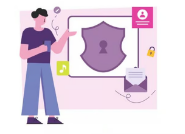As we dive into National Cybersecurity Awareness Month this October, the first week focuses on making our homes a haven for online safety.
Understanding the Importance of Home Cybersecurity
Our homes have become digital hubs filled with various devices that connect to the internet, including computers, smartphones, tablets, smart TVs, and IoT (Internet of Things) devices like smart speakers, thermostats, and cameras. As we embrace this technological convenience, we also invite potential cyber threats into our lives.
Cybercriminals often target home networks because they tend to have weaker security measures than corporate networks. By strengthening your home cybersecurity, you can significantly reduce the risk of data breaches, identity theft, and other cyber threats.
Key Steps to Secure Your Home Network
- Change Default Settings and Passwords
Most routers and smart devices come with default usernames and passwords that are easily accessible online. To prevent unauthorized access, change these default settings to strong, unique passwords. Avoid using easily guessable information and consider creating a passphrase that’s both complex and memorable.
- Secure Your Wi-Fi Network
Ensure your Wi-Fi network is secured with WPA3 encryption or at least WPA2. This level of security helps protect your internet connection from being accessed by unauthorized users. Additionally, consider hiding your SSID (the name of your network) to make it more difficult for intruders to find your network.
- Enable Network Firewalls
Most modern routers come with built-in firewalls that can help protect your network from external attacks. Ensure that this feature is enabled and configured correctly. A firewall acts as a barrier between your internal network and external threats, adding an essential layer of protection.
- Keep Your Devices Updated
Regularly check for updates for your operating systems, applications, and devices. Software developers frequently release updates to patch security vulnerabilities. By keeping your devices up to date, you reduce the risk of falling victim to cyberattacks that exploit outdated software.
- Implement Two-Factor Authentication (2FA)
For devices and accounts that support it, enable two-factor authentication. This adds an extra layer of protection by requiring not only a password but also a second form of identification before granting access, typically a code sent to your phone or email.
- Educate Your Family About Online Risks
Cybersecurity is a shared responsibility. Make sure all family members understand basic online safety practices. Discuss the importance of recognizing phishing attempts, avoiding suspicious links, and managing privacy settings on social media.
- Secure Personal Devices
If you’re using personal devices for work or education, ensure that they are secured as well. Use antivirus software, enable firewalls, and regularly back up your data. This practice ensures that even in the event of a cyber incident, your crucial information remains safe.
- Set Up Guest Networks
If you frequently have guests who need to use your Wi-Fi, consider setting up a separate guest network. This keeps your primary network secure and limits access to your devices and sensitive information.
As we embark on National Cybersecurity Awareness Month, making your home a haven for online safety is the first step toward ensuring a secure digital environment for you and your family. By implementing these practical steps, you not only safeguard your personal information but also cultivate responsible online habits within your household.
Remember, cybersecurity awareness starts at home. Taking the initiative to improve your home network’s security today will help protect your family’s digital lives tomorrow. Stay informed, stay secure, and embrace the knowledge that a little vigilance goes a long way in creating a safer online community for everyone.
